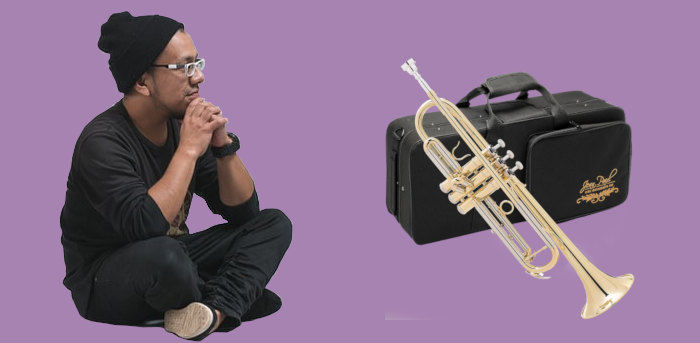
This post may contain affiliate links and we may receive compensation if you purchase products linked to below. As an Amazon Associate, we can earn from qualifying purchases. Please see our Terms and Conditions for details.
Is the Jean Paul USA TR-330 standard student trumpet the right trumpet for you?
Just scanning the dozens of student trumpets for sale online—many with strong customer reviews—it can be hard to know for sure.
Impressive selection? Sure. Overwhelming? Definitely.
But I can share my experience with this trumpet and tell you everything I know to help you make an informed decision yourself.
So let’s take a trip and explore one of the most popular student trumpets available, starting with the brand.
The Jean Paul USA brand
Based in the United States, Jean Paul USA is a fairly popular brand among trumpet players and other musicians. The company sells trumpets and other brass instruments like trombones, as well as woodwinds like saxophones, flutes and clarinets.
They appear to manufacture many of their instruments in China, including the TR-330–though even premium instrument makers like Buffet Crampon have offshored some of their production. The company sells trumpets and other brass instruments like trombones, as well as woodwinds like saxophones, flutes and clarinets.
Jean Paul USA instruments cover a wide range of competence—from student instruments like the TR-330, to more advanced models. This is a common trait among higher-end brands and shows a deeper expertise and knowledge of quality than you’ll typically find in lesser-known brands.
Many musicians also appreciate the brand’s commitment to providing good after-sale service, practically unheard of among the many lesser-known brands with trumpets appearing online beside the TR-330. And customer service becomes a relevant factor when exercising a warranty, as we’ll see.
For these reasons, Jean Paul USA is generally a brand that stands behind their instruments and takes responsibility for resolving any customer complaints.
Key criteria for rating the Jean Paul USA TR-330
Whether we’re reviewing a Jean Paul USA trumpet like the TR-330 or any other student trumpet, most or all of the following criteria will likely be relevant. Let’s discuss these as they relate to the TR-330.
Pros
- Warm and resonate tone
- Durable construction
- Decent resale value
- Excellent customer support
Cons
- Sticky valves
1. Price
I’ve seen new student trumpets ranging in price from as little as $80 to as much as $1,400 or more. Jean Paul USA’s TR-330 standard student trumpet sits in the low-mid range, typically at around $250 from retailers like Amazon.
Compared with renting a trumpet, which is typically $20-50 per month for a student model, buying one new could make more sense for you.
And the TR-330, like many Jean Paul USA instruments, tends to retain much of its value. So if you later choose to resell the trumpet, as long as it’s still in decent condition, you can expect to recoup nearly half the cost of buying it new.
While price is a logical starting point, there’s much more to factor into buying a trumpet. So unless this model is definitely outside your budget, let’s move on.
2. Playability
Some trumpet models are easier to play than others. And no two models, even if they’re both student trumpets, will have the same exact feel, response and handling—in a word, playability.
Though playability is largely a subjective factor that will vary from one trumpet player to the next, there are some objective features of trumpets that can give them a relatively better feel.
Not surprisingly, many first-time trumpet students who begin learning to play on a hard-to-play instrument often don’t stick with it. A trumpet that’s easy to play helps encourage a student. While a trumpet that’s hard to play often discourages the same student.
The TR-330 performs well overall in terms of playability. It’s lightweight at 2.2 lbs., which makes it easier to handle. And it’s built with features in mind for the beginner trumpeter. Here are the main features to note in relation to ease of play (related: Parts of a Trumpet Explained):
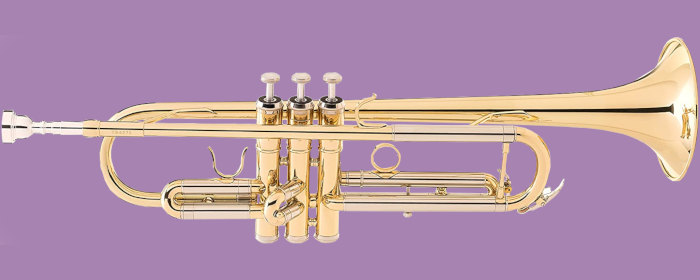
Mouthpiece
Despite it’s small size, the mouthpiece is a complex part of the instrument that affects several different aspects of performance (related: Trumpet Mouthpiece Sizes, Shapes and Features).
When it comes to student trumpets, the ideal mouthpiece is usually one with a relatively small rim, which many trumpet players believe gives them greater control, and a middle-sized cup, giving the trumpeter reasonable volume.
The Jean Paul USA TR-330 includes a 7C mouthpiece, which is a common mouthpiece included with a student trumpet because its a fairly well balanced model. And without knowing anything about the particular student who will be playing it, this mouthpiece is a good one to start on.
Remember that different players have different mouth shapes and preferences. The 7C mouthpiece is a good mouthpiece for most players starting out. But for others, they may want to change mouthpieces once they’ve mastered the basics of trumpet.
Sticky valves
Musicians’ most common criticism of the TR-330 student trumpet is probably that it has sticky valves. Valves that don’t respond quickly and smoothly inhibit the trumpet player and disrupt their rhythm. Sticky valves can be a serious problem, since even a great trumpet player can’t perform well with an instrument that has sticky valves.
Just how common are sticky valves with the TR-330?
According to feedback from 411 customer reviews of this model across online shopping platforms, 11 percent of customers say they experienced sticky valves with this model, typically within the first six months of owning the trumpet.
The remaining 89 percent either explicitly said the valves were working as expected (e.g. “smoothly” or “well”) or didn’t mention the valves having any sticking problems.
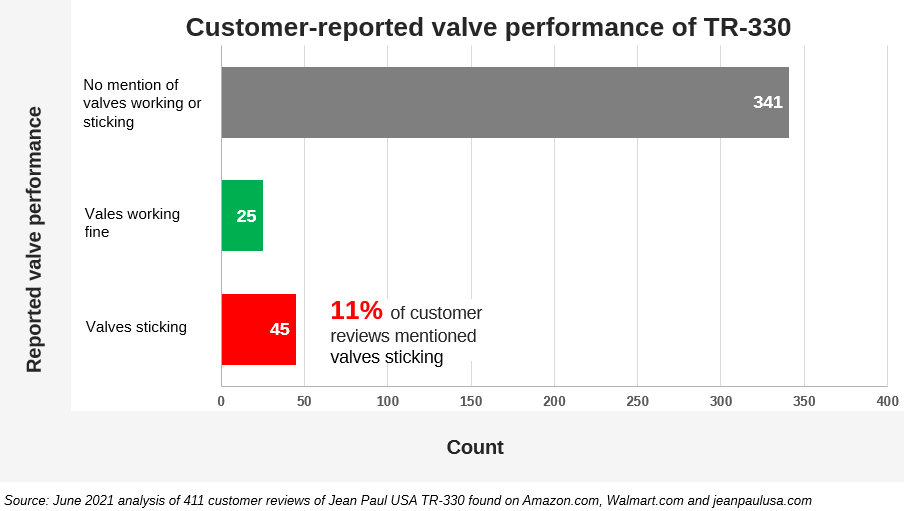
What about the 11 percent with sticky valves?
51 percent of customers in this group were able to fix the valves with one of the following remedies:
- 9 percent said simply cleaning and oiling the valves fixed them
- 4 percent said switching valve oils and then oiling again fixed the valves
- 38 percent said customer support resolved the valve issue, typically by sending them a new replacement trumpet
The remaining 49 percent of customers reporting sticky valves did not fix them successfully, with one customer reportedly contacting customer support to no avail.
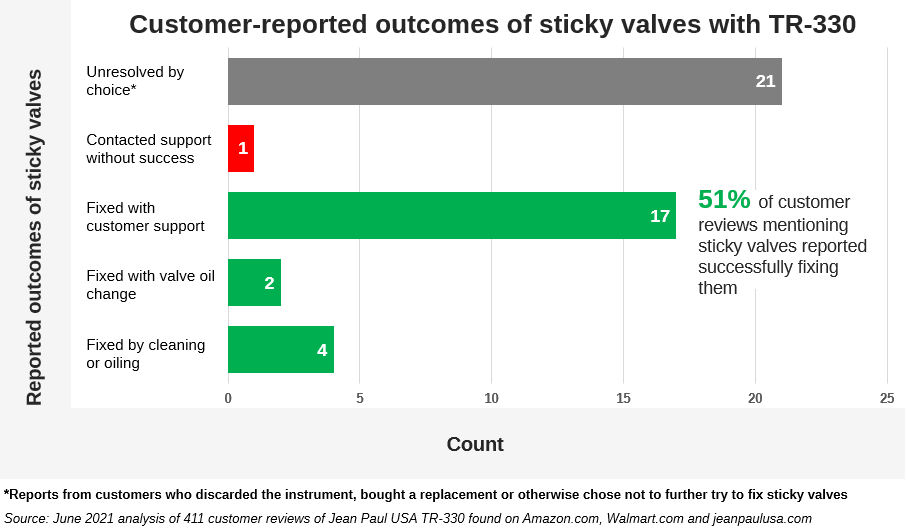
So, should you worry about sticky valves with the TR-330?
An 11 percent chance of getting sticky valves is not insignificant. And although the majority of customers reporting this problem were able to fix it, most ended up needing to contact Jean Paul USA for a replacement.
It’s possible that many of these customers could have fixed their valves by oiling them, or changing oils, if they only knew. But even with great customer support, you may be waiting a couple weeks for a replacement trumpet. Only you can decide your tolerance to risk.
Bore
The bore is the hollow space inside a trumpet’s tubing. Its diameter is measured from the second valve, often in inches. Many musicians argue that bore size can affect a trumpet’s sound characteristics (related: Trumpet Bore Size: How Much Does it Matter?).
The TR-330 model trumpet has a bore size of 0.459 inches. This is on the medium-large end of the range of bore sizes in Bb trumpets and is typical of most models apart from professional ones.
3. Trumpet durability and maintenance
If you’re looking for a student trumpet that will last more than a few months, durability and maintenance will be something to consider.
Our biggest concern when it comes to trumpet durability is corrosion. Yes, it’s possible to dent or break components on a brass instrument. But provided the musician takes reasonable care in handling their trumpet, corrosion is a more realistic problem you’re likely to face.
The TR-330 is an overall durable student trumpet, especially for the price. The chosen material for specific parts of the instrument has the greatest impact on durability and maintenance.
Lead pipe material
The lead pipe of a trumpet connects the mouthpiece to the main tuning slide.
Most trumpet lead pipes are made from gold brass, yellow brass or red brass (a.k.a. rose brass), each being an alloy with a different mix of copper and zinc. Red brass contains the highest percentage of copper, which makes it the most resistant of the three to corrosion. The Jean Paul USA TR-330 has a red brass lead pipe.
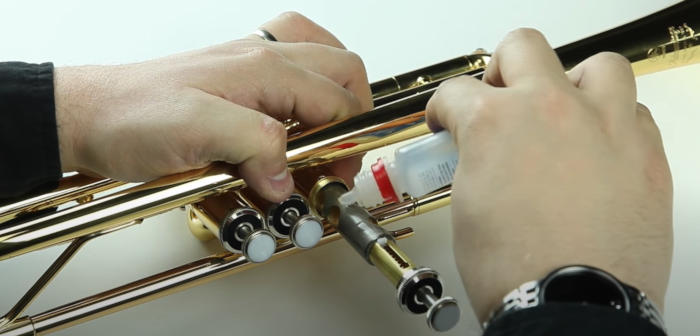
Valve material
Valve pistons are usually either nickel plated, stainless steel, or made from Monel, a mostly nickel-copper alloy. The question over which material is the best choice for trumpet valves remains controversial among musicians.
Nickel-plated valves are usually nickel-silver with a pure nickel plating. This is usually the lowest-cost option and is typical for many student trumpets. Though they can have good response and smoothness, the main concern is the quality of the plating. A poor-quality plating is likely to flake off, which can cause the valves to stick over time.
Pistons made from Monel, are more resistant to corrosion than nickel-plated ones. Monel pistons are also more expensive and more commonly found in intermediate and professional trumpets. Since they’re not plated, you won’t see the kind of flaking you might with nickel-plated valves.
The TR-330 trumpet has stainless steel pistons, which have the advantage of being inexpensive and durable. Stainless steel has become the valve material of choice for many trumpet brands at the intermediate and professional level because its harder alloy offers a narrow tolerance for fitting within the casings, which can improve intonation.
Ultimately, I’d say the durability of the valves depends more on the quality of the material and workmanship as well as the care taken to regularly clean and oil the valves than on which of the above materials is used to manufacture them.
Trumpet finish
Trumpets normally have a surface coating, either a plating or a lacquer, to protect the underlying material and give the instrument a shine (related: Trumpet Finishes: Raw Brass, Plating or Lacquer?).
Musicians sometimes prefer a plating because they believe it offers better sound and response–though there is much debate about any difference. The main drawback to plating is the additional maintenance needed to keep it from tarnishing.
Lacquers tend to be less expensive and require less frequent cleaning. They’re also more susceptible to scratches and wear over time. If you happen to dent a silver-plated trumpet, for example, you may be able to repair it without leaving any signs of the dent. Whereas a dent in a lacquered trumpet can be repaired, but the lacquer will be scarred.
The TR-330 comes with a gold lacquer finish. This gives it a nice radiance without the added expense of a silver or gold plating. Just keep in mind that any damage to the lacquer will remain there unless you pay $200-300 or more to have it re-lacquered.
4. Sound and intonation
A good student trumpet will have a bright tone that resonates without sounding shrill. And although differences in sound aren’t usually obvious to first-time trumpet players, they do become important as a player advances.
Many factors affect how a trumpet sounds, from aspects of the player’s technique like their embouchure, to the instrument’s physical traits like the mouthpiece, bore and bell.
Intonation has more to do with consistency of playing different notes across registers. Every trumpet has certain notes that are harder to hit naturally. And trumpet players will have to adjust their technique to play these.
The TR-330 has a strong sound and even intonation for a student trumpet. The red brass chosen for the lead pipe gives the instrument a soft, not overbearingly bright, tone. This helps the trumpet blend better with the rest of a brass section in an orchestra band. The lower notes have the characteristic “dark” tone preferred in the trumpet. And most musicians find the high notes are reasonably easy to play.
Bell
The effect of the bell on a trumpet’s sound is a bit more complex. For one, differently sized bells will project differently. Most student trumpets have a bell measuring about 5” wide, which is a bit on the larger side and lends to better projection. With its bell measuring 4.92” wide, the TR-330 is typical in this regard.
Also, like most student models, the TR-330 has a bell made from yellow brass. While you can get a warmer, darker tone with red brass, and even more so with silver, the added material cost probably isn’t worthwhile for a student model.
Finally, trumpet bells are typically constructed in one of two ways:
- One-piece bells are hammered into shape by hand. These tend to vibrate more freely and hence are more likely found in the best professional models.
- Two-piece bells are welded together. These won’t vibrate quite as freely but are less expensive to make and most commonly found in beginner and intermediate models.
The TR-330 performs well enough that many advanced musicians will use it as a back up for a more expensive professional trumpet. And its sound features make it an ideal marching band trumpet.
5. Commitment to playing trumpet
This next part relates as much to the person you’re buying a trumpet for as to which trumpet model you choose.
Learning to play trumpet is no easy task. And you probably don’t want to spend a lot of money on an instrument for someone who isn’t committed to playing it.
Consider the following questions about this person:
- Have they played trumpet or any other musical instrument before?
- How enthusiastic are they about learning to play trumpet?
- Are they the type of person to stick with a hobby for more than a year? Or are they more fickle with their interests?
The answers to these types of questions should guide your purchasing decision. Given its low price and decent workmanship, the TR-330 doesn’t need a massive commitment on the part of the student to justify the purchase.
Then again, if we’re talking about a trumpet player with a few years of experience already behind them, I might recommend a higher-end model instead.
6. Accessories included
Most trumpets, especially student models, will include some accessories. These may include a carrying case, valve oil, a cleaning kit and others.
Brands or dealers typically package these with their trumpets to make them more attractive to customers. Unfortunately, in my experience most included accessories aren’t great quality. Some are practically useless.
But having some accessories included with your trumpet can still be a plus if you don’t know what you’ll need. Indeed, a trumpet player without valve oil, for example, won’t be able to play for long, if at all, before they need to buy some.
Here’s a list of accessories you can expect will be included with the Jean Paul USA TR-330, depending where you buy it:
- Soft-shell carrying case
- Cleaning cloth
- Valve oil
- White gloves
These accessories are OK overall. The carrying case comes with backpack straps for easier carrying. And the cleaning cloth comes handy when cleaning the trumpet.
White gloves aren’t really essential. But they’re nice to have if you want to avoid leaving fingerprints on the instrument. They also give musicians in a marching band a more professional appearance. Of course, there’s no guarantee they’ll fit.
Valve oil
The only accessory that I’d suggest you replace upfront is the valve oil. The oil included with the TR-330 just doesn’t work well. The trumpet might play fine for 30 minutes to an hour but then will need to be oiled again. This is a main reason why so many people have said the valves lock up on them.
If you buy the TR-330, I suggest also picking up a bottle of Al Cass or any similar valve oil. A single bottle usually costs around $5 or $10 online.
7. Manufacturer’s warranty
There’s no guarantee that any trumpet you buy will not come with a defect, no matter how minor. Mass manufacturing isn’t perfect. And sometimes trumpets ship with scratched finish, sticky valves or some other imperfection.
A manufacturer’s warranty, along with responsive customer support, is what separates the reputable trumpet brands from the many no-name ones you’ll find on Amazon and elsewhere.
When you buy a new Jean Paul USA TR-330 student trumpet you also get a 1-year warranty that covers any manufacturing and quality defects with the instrument.
The brand also has a reputation for quickly resolving any customer complaints with their products. Their customer support team has been known to send a new trumpet to replace a damaged one free of charge, even when the customer themselves was negligent with the product. The company often provides a free shipping label to customers for sending back the damaged trumpet and also frequently covers the cost of any repairs in lieu of replacement.
Sure, there are more expensive trumpet brands that offer warranties lasting three or five years. But the hassle-free warranty Jean Paul USA includes gives musicians a lot of confidence in their instruments.
Specifications
Here’s an overview of the specs for the Jean Paul USA TR-330:
- Key: Bb
- Lead pipe: Standard taper
- Lead pipe material: Rose brass
- Bore size: ML 0.459” (11.65mm)
- Bell material: Two piece, yellow brass
- Bell diameter: 4.92” (125mm)
- Mouthpiece: 7C
- Valves: Stainless steel
- 1st Valve slide: Thumb saddle
- 3rd Valve slide: Adjustable ring with slide stop
- Features: Yellow brass slide tube receivers
- Finish: Gold lacquer
The bottom line: Is the Jean Paul USA TR-330 your ideal trumpet?
That just about covers everything to consider when buying a trumpet. But although we’ve said about all there is to say about this model, one question might still be nagging you: Is the Jean Paul USA TR-330 the right trumpet for you?
Well, at around $250, this trumpet offers good value for money. It’s made by a well-known brand with exceptional customer service. It’s durable with a rich, resonant sound. It comes with most of the accessories a new student will need to get started.
And even if you or the student decide to quit playing in a few months, you can still resell the instrument and get back a fair amount of what you paid.
With all that said, unless you’re looking for a trumpet for someone who’s been playing for a few years or more already, it’s hard to see why you wouldn’t choose the TR-330.
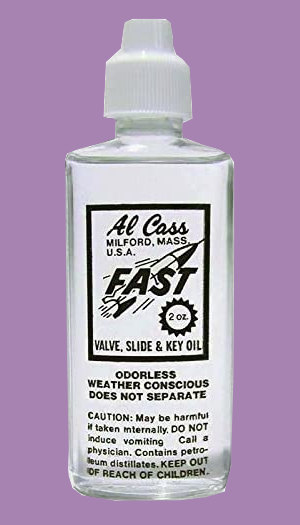
Leave a Reply